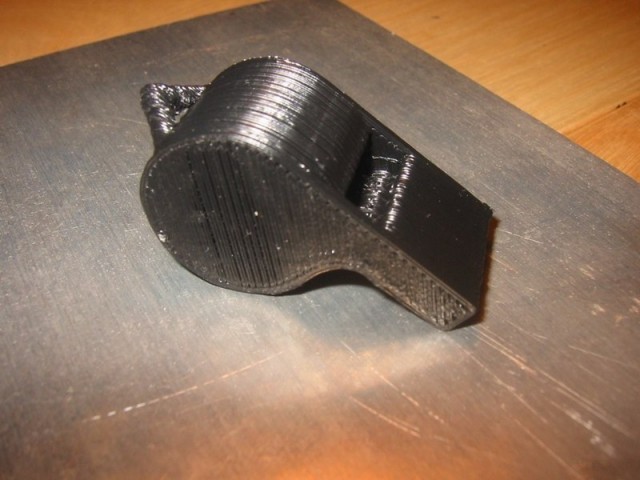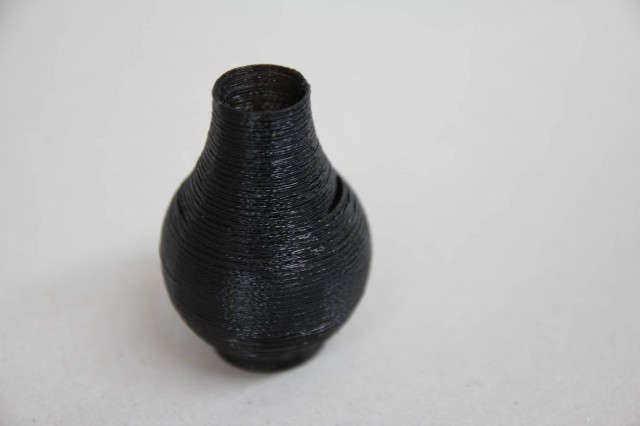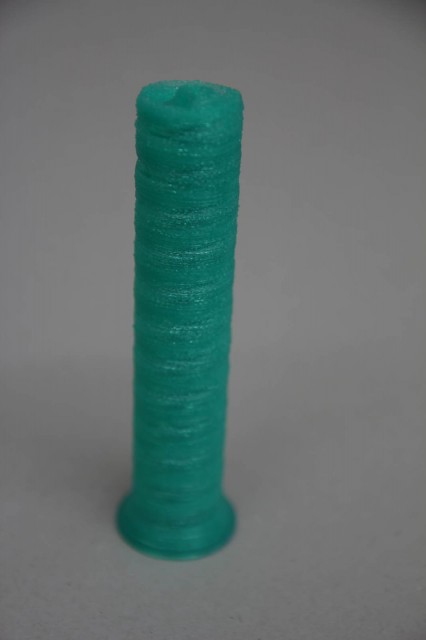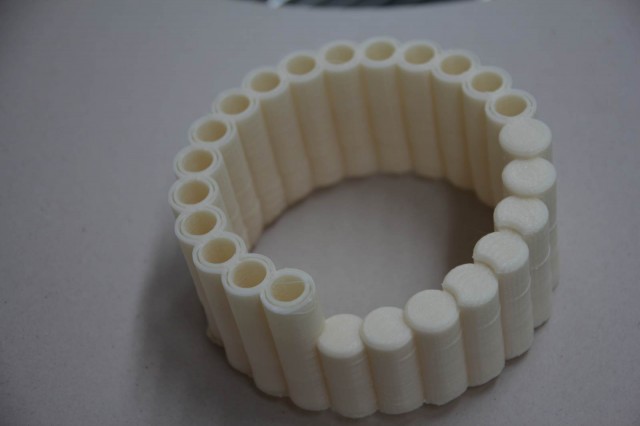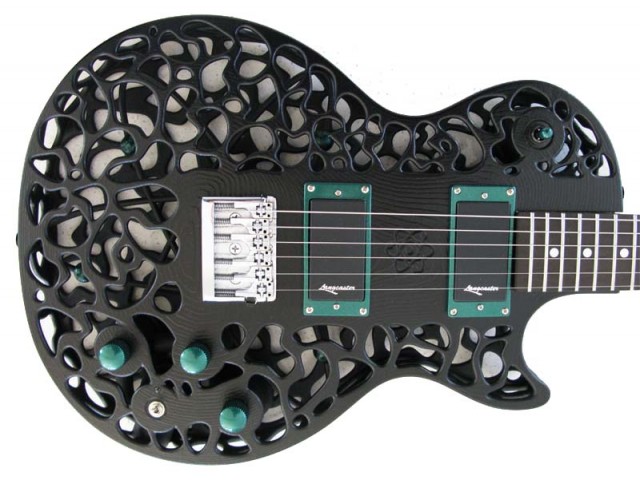
3D printing can not only replicate existing forms – it can produce new ones. The Atom Guitar, from Odd Guitars. Courtesy the manufacturer.
3D printing has quickly risen to buzzword, from a technology initially of interest primarily to hobbyists to one that is catching mainstream business and consumer attention. But the actual substance continues to catch up with potential and expectations.
Here are six examples of musical instruments that have taken on 3D printing as a challenge. They may not yet compete entirely with wood and other conventional materials. But they do actually play music, and by pushing against the limitations of the technology, they both reveal what’s possible and refine printing’s usefulness.
Arvid Jense, Create Digital Music’s summer intern and himself both an industrial designer and musician, shares his favorite instruments from his research and talks about where all of this might go.
Guitar body by Odd
The only commercial-available instrument on this list, the Odd guitar sold for US$3500, including a hard case, assembled as a complete guitar.
Details:
The Atom 3D printed guitar: A Les Paul inspired guitar with an internal atom with spinning electrons. The bodies are printed, using Selective Laser Sintering, by 3D Systems in the USA, on an sPro 230 SLS system. The material being used for these guitars is Duraform PA which is a very strong form of Nylon. The resolution for the prints was 0.1mm (which means that each layer that makes up the guitar body is 0.1mm thick). The guitars feature a wooden inner core (choices of Mahogany or Maple, etc.) that links the neck to the bridge, which allows us to customize the sustain and tone of the instrument to suit the musician, and a number of options for hardware, etc.
Working Flute by Amit Zoran at MIT Media Lab
Zoran’s flute is printed in one piece, including valves (excluding springs). It uses multiple materials.
While an interesting (and functional experiment), it had its flaws – before you run out to get a 3D-printed flute. From the YouTube description:
This isn’t a perfect instrument, some of the keys didn’t close well and Seth had to improvise, and to use some fingers to close keys that didn’t seal well. This is the reason – as some of you have noticed – the fingering seems odd.
That said, Zoran’s instrument design work could be a topic in itself, a futuristic, fanciful cornucopia of wacky guitars and other instruments:
http://web.media.mit.edu/~amitz/Amit_Zoran_home_page/Works.html
Violin by EOS
The Economist covers these 3D-printed violin bodies – and spares no hyperbolae in the headline:
Print me a Stradivarius: How a new manufacturing technology will change the world
The EOS violins feature a printed body, but employ traditional parts for the other components (bridge, strings, etc.).
Zaggo Whistle
http://www.thingiverse.com/thing:1046 (133 prints documented on thingiverse)
It might not be as sexy as printing a Strad, but sometimes simple is effective. This whistle is the epitome of DIY printed instruments – you print it, and it works perfectly.
Produced by Zaggo in 2009, the design has been featured on Thingiverse and is designed such that it can be printed on the Makerbots popular with hobbyists and hacklabs.
Saxophone mouthpieces by TUDelft students
Leo van Oostrum test Mondstuken from Titus Wybenga on Vimeo.
Components – as we saw with the synth parts last week – could ultimately have a place as much as entire instruments. In Delft, in the South Netherlands, students tried to accomplish such a thing, experimenting with replicating a Meyer mouthpiece. They used different materials, different machines, and small variations including internal ‘wings’.
http://sax2011.weblog.tudelft.nl/
This Just In: 3D-Printed Acoustic Guitar
As we were completing this article, yet another 3D-printed musical instrument surfaced. While electric guitars with 3D-printed bodies have been done before (see above), this instrument is acoustic. It’s the work of Scott Summit, who has already made an impact on the 3D printing community by suggesting new prosthetic applications.
The World’s First 3D-Printed Acoustic Guitar [Business Week]
Arvid’s Thoughts
Ed.: Arvid also sent along some examples of his work, pictured below. He notes that none of these made satisfactory sounds. Upcoming: a temple block experiment that fared better. You can expect similar frustrations, printing your own instruments – but, then, challenges are half the fun of design, if you have the stomach for them.
While all of these things are cool, they’re all replications of existing traditional instruments, and aren’t touching the new geometrical and structural possibilities of 3d printing. (Though, this quite mirrors early electronic instruments, which were mostly trying to emulate existing instruments in sound.) Ed.: Not to argue with Arvid here, but I’m not sure that’s entirely true of electronic instruments, though it did mirror the early commercial experience of the synthesizer.
Some of the advantages 3D printing has for musical instruments is, firstly, that there is no skilled/trained instrument maker needed to manufacture the instrument, which could make these replicated instruments more accessible to beginning musicians. Secondly, that instrument designers from around the world can easily collaborate over the Internet (which might ease the initial disadvantages of printing). And thirdly, this could, over time, turn into a more economical and environmentally-friendly method of producing instruments, in which instruments are made on demand, and the only transportation is your trip to your local Fablab.
Current disadvantages are that printing on commercial machines is expensive and that printing on DIY machines is often inaccurate. Also, there is not much of an instrument-making community yet, which makes most printed instruments one-offs.
As I said before, I feel like current projects aren’t making full use of the possibilities 3D printing offers: control over (internal) geometry and structure which isn’t possible with traditional methods. This is why I started a research project trying to make a start in figuring out what exactly we can do with these possibilities. My pre-research can be found on 3dprintedinstruments.wikidot.com. At the moment, I’m using three repraps at the ArtEZ ArTechlab to experiment with three directions:
1. Getting a simple pan flute to make musical sounds.
2. Experimenting with what kind of timbral changes the infill patern makes in the sound of a simple temple-block.
3. Making spiral and folded up tubes to try to get something interesting out of internal structures.
I really welcome people to comment and criticize my and fellow 3D instrument printers’ work, and I welcome people to collaborate on my site and to derive my instruments (once they’re on thingiverse).
Ed.: There you have it. If you thought we were just going to copy-and-paste some cool 3D-printed things and be done, not here – nope, I hope this actually starts some practical collaboration and experimentation to find out what 3D printing can, and can’t do. And I welcome discussion of other new instrument making techniques, too.
Stay tuned to CDM and MeeBlip.com for more of what Arvid did this summer – and continues to do, back in Holland. Arvid, we miss you here in Berlin. -PK
